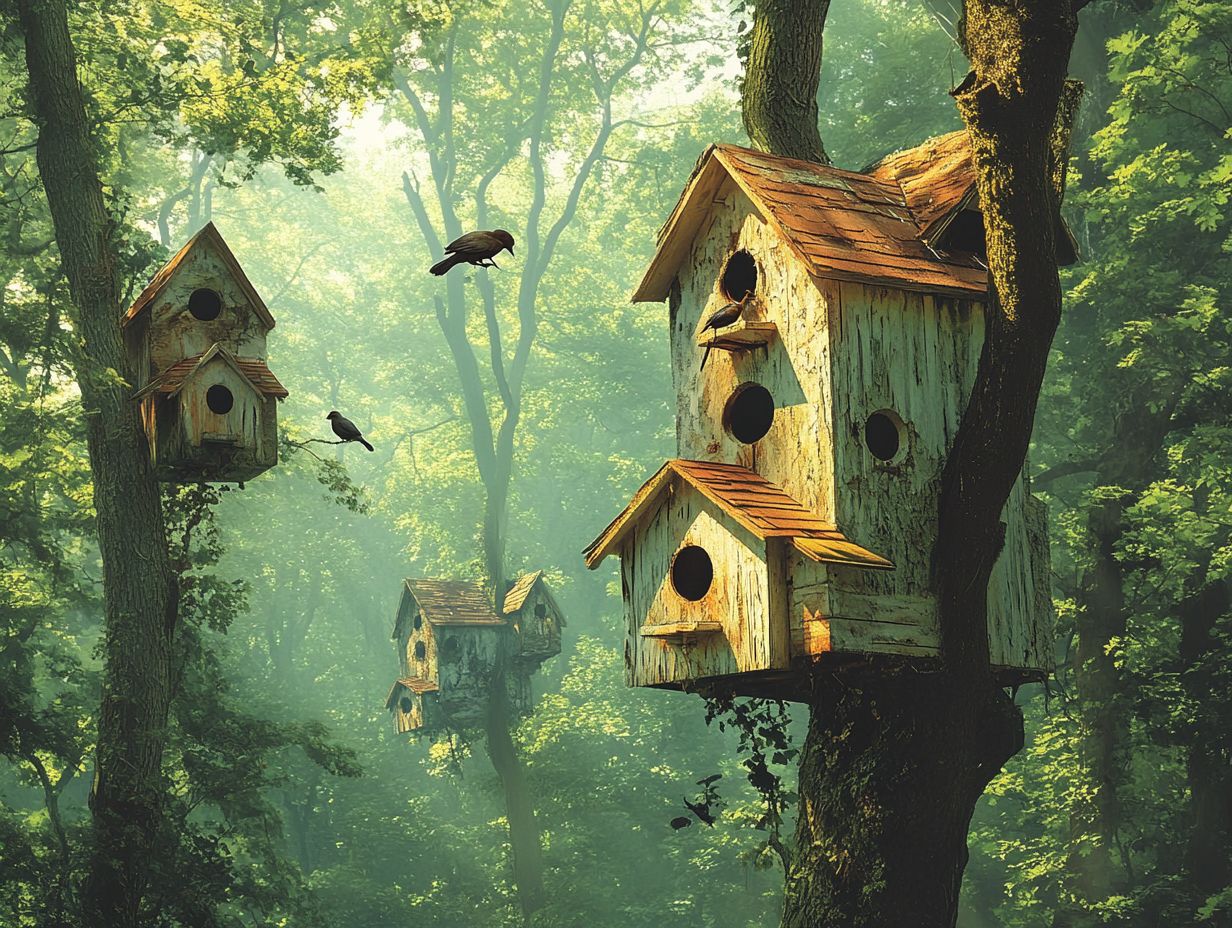The Impact of Noise on Bird Housing
Birds are incredible! Their well-being is closely tied to their housing. Proper housing is essential for birds. Noise pollution can negatively impact their behavior and health.
Explore alternative housing options. A serene sanctuary benefits your feathered friends. Understanding the link between bird housing and a peaceful space is vital. This knowledge ensures their happiness and health.
Contents
- Key Takeaways:
- The Importance of Bird Housing
- The Effects of Noise on Birds
- Common Sources of Noise Pollution for Birds
- Creating a Quiet and Safe Environment for Birds
- Alternative Housing Options for Birds
- Frequently Asked Questions
- What is the impact of noise on bird housing?
- How does noise affect bird behavior?
- What types of noise can be harmful to birds?
- How can noise impact the breeding success of birds?
- What are some signs that noise is negatively impacting bird housing?
- What can be done to minimize the impact of noise on bird housing?
Key Takeaways:

- Proper housing is essential for birds.
- Noise affects bird behavior. It can cause stress and lower immune response.
- Common noise sources include traffic and construction.
The Importance of Bird Housing
Proper bird housing is vital for boosting local bird populations, enhancing their breeding success, and advancing broader wildlife conservation initiatives. High-quality habitats play a crucial role in reproductive success and foster community engagement through citizen science projects that monitor bird populations and their responses to noise exposure.
As urban areas expand, we must ensure suitable housing for birds to prevent the loss of living spaces. This commitment promotes healthier backyard environments and enriches the ecosystem’s ecological services, creating a win-win for both nature and the community.
Why Proper Housing is Essential for Birds
Proper housing establishes conditions that promote breeding success and overall wildlife health. This fosters stable populations capable of thriving even in the face of challenges such as noise pollution and related health impacts.
When birds have access to suitable nesting sites and shelter, their stress response is significantly minimized, resulting in lower stress hormone levels. Elevated stress hormones can impede reproductive efforts and compromise overall health, affecting chick survival rates under the strain of environmental noise.
By creating environments that minimize exposure to challenges like habitat destruction and urban sprawl, you provide safe havens and support a robust avian population, which is crucial for maintaining a variety of species. These habitats enable birds to engage in vital behaviors like foraging and courtship, critical for successful breeding seasons and long-term sustainability.
The Effects of Noise on Birds
Noise pollution profoundly affects bird populations, disrupting their communication and interfering with mating calls. This incessant din can induce chronic stress, compromising their reproductive success and affecting their development stages.
Elevated noise levels from sources like traffic noise, natural gas compressors, and lawn equipment not only alter the behavior of songbirds but also trigger changes in stress hormones, significantly impacting their overall health and longevity.
How Noise Affects Bird Behavior

Noise pollution significantly alters bird behavior, creating background noise that makes it hard to hear important sounds. This hampers predator detection and disrupts essential mating calls for reproduction.
In urban environments filled with clamor, many bird species, like zebra finches and western bluebirds, struggle to communicate effectively. This can negatively impact their foraging success and social interactions.
Noise can disrupt essential acoustic signals necessary for communication. For instance, you might notice that zebra finches have difficulty hearing the calls that signal the presence of food or potential mates.
Similarly, western bluebirds may not reliably pick up on calls that warn them of approaching predators, putting them at greater risk.
Interestingly, some birds adapt their calls or foraging strategies to deal with ongoing noise. While this adaptability may enhance their chances of survival, it raises important questions about the long-term effects of environmental stressors, like noise-induced diseases, on bird populations.
Potential Negative Consequences
The potential negative consequences of noise pollution on birds are significant and far-reaching. Chronic exposure can lead to noise-induced diseases and serious health issues, particularly affecting their lifespan.
This relentless onslaught of disruptive sounds interferes with their communication and mating rituals. It also elevates stress levels.
Such stress can compromise their immune systems, leaving them more vulnerable to infections and diseases. It may even affect their stress hormone levels.
Prolonged exposure to high-decibel environments has been linked to conditions like avian hypertension and increased cardiovascular problems. These stressors can diminish reproductive success and alter foraging behaviors, ultimately affecting population dynamics and the resilience of bird species in changing environments.
When birds are compelled to expend extra energy to navigate and survive in these noisy habitats, their overall health declines. Chronic fatigue and reduced resilience against environmental threats become pressing concerns, impacting their survival.
Common Sources of Noise Pollution for Birds
Common sources of noise pollution that negatively impact bird populations include traffic noise, lawn equipment, and the operation of natural gas compressors. These factors significantly contribute to elevated noise levels in urban and suburban areas, creating an environment that is less conducive to bird life.
Identifying and Addressing Noise Sources
Identifying and addressing noise sources is vital for your wildlife conservation efforts. By doing so, you empower your community to take meaningful action in reducing noise levels that can impact birds’ noise tolerance and overall health.
Utilizing methods like sound mapping and community surveys allows you to pinpoint specific areas where noise pollution runs rampant. You can develop strategies that mitigate its effects on local wildlife health.
These initiatives foster a collective understanding of noise issues and inspire local groups to advocate for quieter environments.
Educational programs highlighting the effects of noise pollution on bird species can energize community members to get involved. You can discuss strategies to improve noise tolerance in birds, such as establishing silent zones in urban areas or incorporating natural sound barriers like trees during community workshops.
By collaborating, your community not only protects local wildlife but also enhances the quality of life for everyone living there.
Creating a Quiet and Safe Environment for Birds

Creating a tranquil and secure environment for birds requires you to implement thoughtful strategies aimed at reducing noise pollution in your backyard habitats. By doing so, you can greatly improve the health of our feathered friends, making your backyard a bird paradise!
Join us in our efforts to create a quieter world for birds!
Tips for Reducing Noise in Bird Housing
Implementing effective strategies to reduce noise in bird housing can significantly enhance the environment for your feathered friends. This improves their feeding behaviors and encourages them to frequent your backyard feeders.
Minimizing disturbances creates a sanctuary that attracts a wider variety of species. It promotes healthier interactions among them. One actionable tip is to incorporate natural sound barriers, like dense shrubs or trees, which absorb and deflect unwanted noise.
Rally your community! Start sound reduction initiatives, such as awareness campaigns emphasizing the importance of maintaining quiet during peak bird feeding hours. This helps preserve their feeding behavior.
Choose quieter materials for birdhouses to help reduce stress on local bird populations. This results in safer and more enjoyable habitats for them, especially during their adolescence.
Alternative Housing Options for Birds
Exploring alternative housing options for birds can lead to quieter, more suitable environments that significantly enhance breeding success.
By doing so, you can support resilient bird populations thriving in urban areas. This is crucial for maintaining biodiversity amidst challenges like habitat degradation.
Exploring Quieter Housing Options
Exploring quieter housing options for birds can significantly enhance wildlife health. It supports the successful development stages of various bird populations.
Implement thoughtful designs, such as quiet nesting boxes and tranquil aviaries. These create safe havens that minimize stress for these remarkable creatures.
These specialized habitats not only shield birds from loud city noises but also encourage natural behaviors like courtship and feeding. These behaviors are vital for their reproductive success and overall health.
Incorporate enhanced features, such as natural materials and strategically placed vegetation. This approach can further attract diverse bird species, enriching the ecosystem around you.
By embracing these quieter housing alternatives, you’re beautifying your surroundings and engaging in meaningful conservation efforts that nurture wildlife. This ultimately leads to healthier, more vibrant urban ecosystems.
Frequently Asked Questions
What is the impact of noise on bird housing?
Noise stresses birds and disrupts their behavior, leading to health problems and decreased breeding success.
How does noise affect bird behavior?
Noise can make birds agitated and cause abnormal behaviors like feather plucking and aggression. This affects their overall well-being.
What types of noise can be harmful to birds?
Loud or sudden noises, such as traffic, construction, or loud music, can harm birds and disrupt their natural habitat.
How can noise impact the breeding success of birds?
Noise can disturb nesting activities, leading to abandoned nests, reduced egg production, and lower hatching success rates.
What are some signs that noise is negatively impacting bird housing?
Signs of noise-related stress in birds include increased aggression, reduced appetite, and self-harm behaviors like feather plucking.
What can be done to minimize the impact of noise on bird housing?
Methods to reduce noise pollution include creating sound barriers, using white noise machines, and promoting noise-reducing landscaping techniques.







